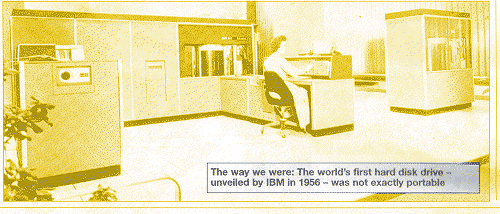
BY JO STEELE
IT WAS the size of two refrigerators and could store only a tiny fraction
of the data that today's camera flash cards can - but 50 years ago it was
a revolutionary concept. And, as the hard disk drive celebrates its half-century
milestone this week, who can imagine life without it?
|
Floppy finally flops |
BY AIDAN RADNEDGE AFTER 36 years and billions of sales, the floppy disk is to join the video player, cassette deck and film camera on technology's scrapheap. The 9cm piece of plastic will no longer be available from Britain's biggest computer retailer. PC World announced last night it would stop selling the disks when stocks ran out. Floppies were once considered among the most vital accessories to computer users and offices worldwide for holding data in an easy-to-store format, which could easily be transferred between PCs. In 1998, 2billion were sold around the world and every computer would have an 'A-drive' to handle them. They would be the all-important back- up in case computers crashed. But floppies hold only 1.44mb of data now little more than a single song, one high resolution picture or a few dozen word-only documents. Instead, memory cards, CD/DVDs and memory sticks can hold up to 1,000 times as much data. Only 700million floppies were sold globally last year- down from 2billon in 1998 - and 98 percent of PCs no longer have an A-drive. PC World's Bryan Magrath said: 'The floppy looks increasingly quaint and simply can't compete.' The first floppy, introduced by IBM in 1971, was a 20cm disk holding just l00kb of data. Ten years later, Sony introduced the standard 9cm floppy. In South Africa, the disks are known as 'stiffies' and in Finland as 'korppus', meaning biscuits.
Video players were consigned to history in 2004, when retailer Dixons stop
selling them. At least they out-lasted the Betamax format tapes which all
but disappeared in 1985 after a two- year battle for supremacy with VHS.
|
|
First, it was the paperless office. Now Bill Gates has a new invention...er, paper BY DANIEL BATES |

THE company that brought the world the paperless office has launched a brand
new invention - paper. Microsoft is renowned for encouraging employees to
ditch paper files and folders. Now it has unveiled a device that turns text
messages into stickers. The IT giant says Text2Paper will provide a futuristic
way to make labels for old-fashioned paper calendars. The US software giant
has also created a gadget that can do exactly the opposite, turn writing
into text messages. People (presumably technophobes) scribble a message on
the Text-It-Notes machine. It then reads the writing and converts it into
a text message. Microsoft claims the inventions 'bridge both the digital
and paper divide, and also the
generational divide between those who are comfortable with paper, typically
the parents, and those comfortable with the mobile phone, the teens.' It
is a far cry from Microsoft boss Bill Gates' vision of the 'paperless office',
which he has been touting for more than a decade. In his book, Business @
The Speed Of Thought, he devotes a chapter to the subject. The Microsoft
website even has an entire section telling us a how to reduce desktop junk.
The devices were unveiled at Microsoft Techfest, in Richmond, Washington.
Techfest brings together Microsoft researchers from all over the world to
show off and swap ideas about technology that is not yet available to the
public. |